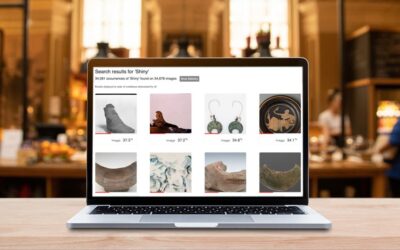How Going Mobile Helps Museums Improve Productivity and Increase Visibility

Ron Aspe
Social media, email, photography and video are continuing to drive adoption of mobile devices. Why not leverage this trend to increase the visibility of your museum’s content and improve collection management efficiency?
Portable Devices Really Do Increase Productivity
While you may still see people lugging laptops into meetings, portable devices such as smartphones, tablets and phone/tablet hybrids are definitely changing how people work—and where. A recent survey by research firm Ipsos MORI reports:
Nearly three quarters—73%—of US office workers using enterprise-owned tablets download personal software and apps, while 52% use personal laptops, tablets and smartphones to store and work on enterprise content.
While it’s no surprise that tablets handed out by employers are leveraged for personal use, the more interesting statistic is that over 50% of employees use their personal devices for work!
As a result, productivity increases in two ways. First, people generally use their personal devices to perform work when they are “off the clock.” Secondly, if they are somewhere other than a work facility during official hours, they can log in quickly should the need arise.
A friend of mine owns a small auto repair shop. He started out with a couple of computers at the front desk. His mechanics kept borrowing them to do research, interrupting both their work flow and the front end personnel who were taking care of clients. Now, each mechanic has a laptop at their tool bench. No waiting, steps saved and happier employees. Next up? Shop tablets they can carry with them as they crawl around and under cars!
A Great Opportunity to do More
Remember the “crackberry”? People used to hold them just out of sight, usually below a desk or conference table, so they could surreptitiously check email. Smartphones and their cousins have now upped the addiction factor. Mobile device owners now have quick access to dozens of applications including FaceBook, LinkedIn, Twitter and beyond. Of course they still check email as well, and since email practically runs our lives, this can (and often will) trigger a need for information, or to take action.
For More Information…
Instead of waiting till they get to a desktop, if patrons and internal users have access to a rich source of information, they will go there NOW using their mobile device. They will continue to do a lot of research at the desktop, but mobile-enabled software helps them achieve instant gratification—and that brings them back for more.
Love them or hate them, Starbucks coffee shops sell a decent cup of joe, provide good service and are ubiquitous. Take a page from their playbook by making your museum’s content universally available (e.g. via your website and Google) and every bit as rich and stimulating.
To Take Immediate Action…
It’s now possible for people to get right to work on their portable devices, in addition to getting information. Who’s going to do that? Actually, almost every smartphone user already does it. Not just for booking plane tickets or hailing taxis—people are performing work tasks using their phones.
SilverCar, an automobile rental company, has completely revolutionized how car agencies operate at airports. Instead of requiring you to find your way to their “conveniently” located garage, you send a text when you’ve arrived, and SilverCar sends one of their employees to pick you up—in your rental car! They then drive you to their rental location, scan your rental’s serial number with a smartphone and off you go. How do they do it? Every employee is equipped with a smart phone—and SilverCar’s operating model is built around the concept of being mobile.
Step Away from The Desk
What would happen if your museum staff were unshackled from their desks? Would they appreciate the convenience? Would it improve productivity?
And if you offer your visitors a rich mobile experience, how will they feel? Will they value in-depth access to knowledge and information that simply cannot fit on an exhibit description card, enhancing their visits to your galleries?
And what about people who have never been to your museum—and may never even have heard of it? Wouldn’t it be great if they discovered your museum while browsing Facebook—and were then able to spend a few minutes browsing your museum’s collection on their smartphone while they finish their afternoon latte?
Go mobile. Be amazing.

Ron Aspe
Stan writes regularly for Lucidea’s Think Clearly blog. Subscribe to ensure you never miss a post with engaging information for KM practitioners and special librarians! Learn about Lucidea’s Presto, SydneyDigital, and GeniePlus software with unrivaled KM capabilities that enable successful knowledge curation and sharing.
Similar Posts
How to Enhance the Museum Object Record with Immediately Available Information
This month’s series focuses on the enhancement of museum object data using “hidden” troves of information. Hidden is in quotes because the information exists and often is not hidden—it just hasn’t been gathered for inclusion in the museum Collections Management System (CMS).
Where the Gaps Live with Traditional Museum Object Cataloging
Standard museum cataloging leverages the usual set of fields that are considered best practice. We tend to refer to this information as “the tombstone information,” meaning it is clear and concise in communicating the “need to know” information.
Considering AI as an Empathy Generator in Museum Spaces
Museums are well established as “empathy generators”, meaning the museum space in combination with artifacts and storytelling can help humans emotionally connect to (or at least better understand) other human groups that are different from their own.
The Application of AI for Museum Collections Online
What excites me the most about Generative Artificial Intelligence (GenAI) application to museum work is its potential to improve discoverability of museum collections online.




Leave a Comment
Comments are reviewed and must adhere to our comments policy.
0 Comments